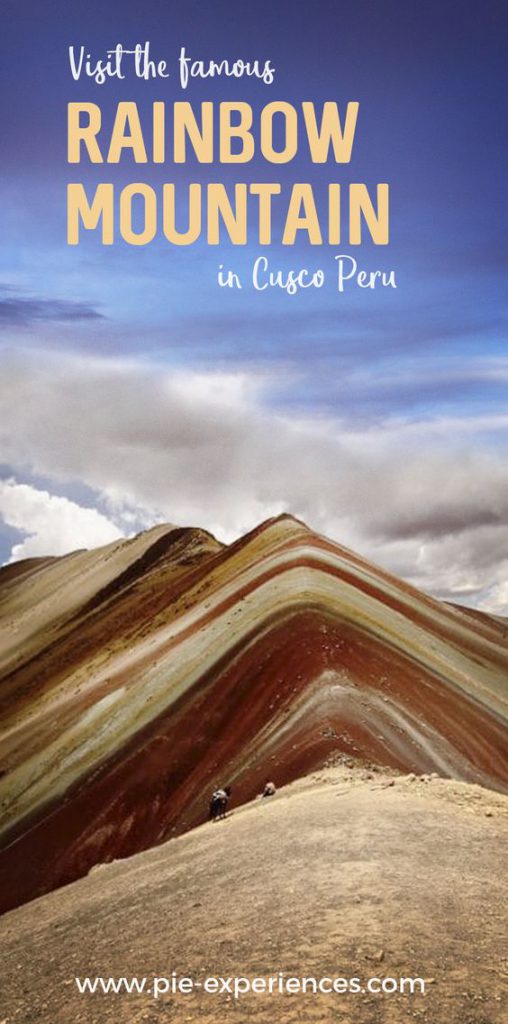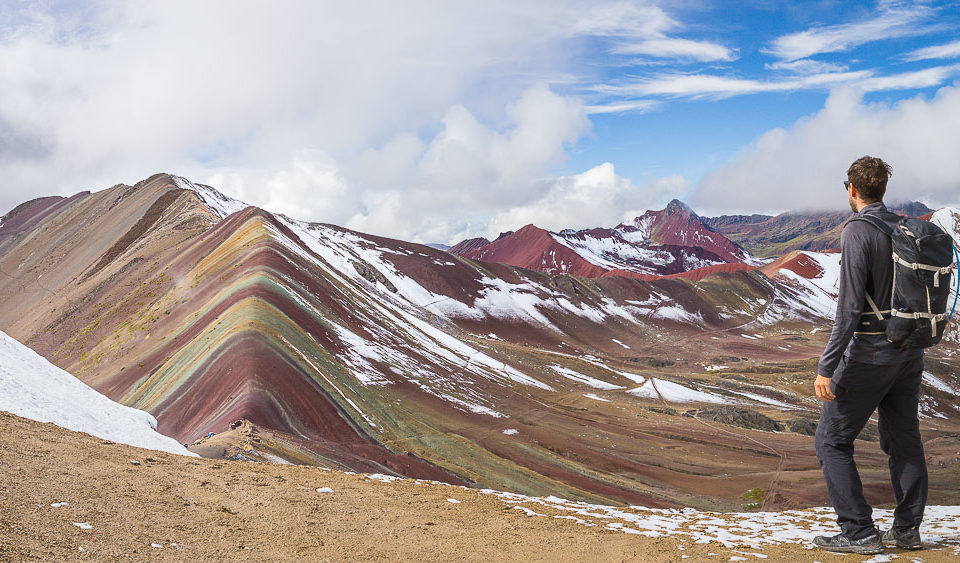Visit Rainbow Mountain: A Wild Day Trip from Cusco That Will Leave You Breathless (Literally)
Are you planning to visit Rainbow Mountain?
Let’s get one thing straight: when you visit Rainbow Mountain, you’re not just hiking another trail. You’re stepping into a surreal painting, 17,000 feet above sea level, where the air is thin, the colors are loud, and the experience is absolutely unfiltered.
Cusco, your jumping-off point, is already perched at 3,400 meters (11,150 feet). A place where even the air has a bit of altitude-induced attitude. From there, a few hours by van and a solid hike take you to Vinicunca—a.k.a. Rainbow Mountain—one of the most unforgettable places to visit in Peru.
Here’s the kicker: the Andes are full of giants—thousands of peaks over 4,000 meters (13,000 feet), stretching from Chile to Venezuela. But how many of them look like they’ve been iced with layers of red, yellow, turquoise, and lavender?
Exactly one.
What Makes Rainbow Mountain So Special?
First, the colors are real. Formed by sedimentary mineral layers compressed over millions of years, this mountain decided to flex its geology like a peacock at a parade.
Second, it wasn’t even a tourist attraction until recently. Locals have known about it forever, but only in the last decade did the world catch on. Now, it’s one of the top day hikes from Cusco and a bucket-list item for anyone visiting southern Peru.
But don’t mistake its Instagram fame for fluff. This place earns every “wow” the hard way—the hike climbs up to 5,200 meters (17,060 feet), where every step feels like a mile and your lungs will be screaming for mercy.
Still, you push on. Because once you get to the top and see the painted ridges of Rainbow Mountain unfold before you, it hits different. This isn’t just another hike. It’s a lesson in awe. And altitude.
The Geography of Rainbow Mountain: Science, Myths, and Pixie Dust
There are two main theories explaining how Rainbow Mountain—or Vinicunca, if you’re feeling respectful—got its wild, impossible colors.
The first involves a clumsy pixie, high on her own supply of enchanted fairy dust, who spilled her magical rainbow paint across the side of a remote Peruvian mountain. The colors stuck, and ever since, Rainbow Mountain has strutted its stripes while neighboring peaks like Ausangate and Salkantay sulk in drab shades of gray, green, and glacier.
This, obviously, is the most widely accepted theory among scientists.
The other, slightly more boring version, involves tectonic plates, mineral-rich sediment, and millions of years of geological drama.
Here’s the breakdown: the Nazca Plate slowly slammed beneath the South American Plate, crumpling the Earth’s crust like an old rug and giving birth to the Andes mountain range. Along the way, volcanic activity brought rare minerals—iron oxide, copper sulfate, sulfur compounds—up to the surface.
Then came time, wind, water, and oxygen. Erosion and exposure revealed the natural colors of each mineral. Later, tectonic forces twisted these once-horizontal layers into vertical waves, painting the mountainside in stripes of red, gold, turquoise, and lavender. A literal rainbow, baked into stone.
The result? A geological freak of nature that looks like someone dragged Photoshop across the Andes and hit “saturation: max”.
But hey—who are we to say which theory is right? Maybe it was science. Maybe it was magic. Maybe it was both, meeting at 17,000 feet where the air gets weird and the Earth decides to show off.
Want to settle the debate yourself?
Visit Rainbow Mountain, breathe the thin air, and decide what you believe. Just don’t forget to thank the pixie. Or the tectonic plates. Whichever you feel deserves the credit.
How to Visit Rainbow Mountain from Cusco (Without Losing Your Mind)
So, you want to visit Rainbow Mountain. Good. But be warned—this isn’t exactly a lazy Sunday stroll. It’s an adventure wrapped in altitude, sleep deprivation, and beauty so raw it’ll knock the air right out of your lungs.
Most Rainbow Mountain tours from Cusco start in the dead of night—pickup is usually between 3:00 and 4:00 AM. You stumble out of bed and into a van full of equally groggy strangers, driving through pitch-black valleys and along winding mountain roads that are definitely not for the faint of heart. Pro tip: don’t look out the window if you’re squeamish about cliffs.
Somewhere around dawn, you’ll stop for a quick roadside breakfast—basic, but functional. Think hot coca tea, bread, maybe an egg if the travel gods are smiling. Then it’s time to lace up your boots and start the climb.
The Rainbow Mountain Hike: What to Expect
From the trailhead, the hike to Rainbow Mountain takes 2 to 3 hours on average. The altitude hits hard—you’re starting at 4,600 meters (15,092 feet) and aiming for 5,200 meters (17,060 feet). The path winds through storybook Andean valleys, where llamas and alpacas wander freely and Quechua villagers pass by wrapped in vivid textiles.
It’s stunning. It’s humbling. And it’s a mud-slicked, slippery mess when it rains—which is often. The trail isn’t well-maintained, and there’s real risk of losing your footing if you’re not paying attention.
Still, it’s not steep… at first. The final stretch? That’s where it gets personal. The last hundred meters feel like dragging your body through molasses. Gravity fights you. The wind mocks you. Your lungs scream.
And then—boom.
Rainbow Mountain rises in front of you like a hallucination. Striped in colors that shouldn’t exist in nature, it feels like the mountain is wearing war paint. You made it. You earned it. And no photo will ever do it justice.
The Descent, the Lunch, and the Ride Back
Coming down is easier on the lungs but harder on the knees. Once you make it back to the base, there’s usually a surprisingly good lunch waiting—hearty, simple, exactly what you need. Think of it as your reward for not passing out on the way up.
Then it’s back into the van, back down the nail-biting mountain roads, and back to Cusco around 6:00 or 7:00 PM, depending on traffic, weather, and road conditions (and possibly your driver’s playlist).
Is It Worth It?
Absolutely. But don’t expect solitude. This is one of the most popular day trips from Cusco, and you’ll be sharing the experience with dozens—sometimes hundreds—of other hikers. If you want more peace, consider a private or alternative route, or combine it with Ausangate for a multi-day trek.
But even with the crowds, the exhaustion, and the early wake-up?
Visit Rainbow Mountain, and you’ll never forget it.
BOOK RAINBOW MOUNTAIN -PRIVATE TOUR from US$129.00
BOOK RAINBOW MOUNTAIN- GROUP SERVICE from US$69.00
On an Ausangate Trek
The Ausangate Trek is an Andes trek that takes you through some gorgeous valleys and past some serious Andes peaks.
This is the highest trek in Peru, and each night you will stay in Andean lodges offering heat, cosiness and comfort.
On day 3 you will arrive at Rainbow Mountain, having already pushed yourself to see a great deal of the awe and beauty that trekking in the Cusco region has to offer.
Via this manner, however, you will get to see far more of Rainbow Mountain, from differing angles, and for much longer.
The one-day trip is just a glimpse, but on the Ausangate Trek you will pass by the full extent of the mountain, stopping for lunch to appreciate exactly what it is you are seeing.
In addition, you will avoid the hordes that ascend daily on the one-day trek.
The Altitude and Weather at Rainbow Mountain
The altitude and the weather are two very important factors to consider before you visit Rainbow Mountain.
During the rainy season, December to March, the path is liable to be very slick and muddy.
As a result, this makes for unpleasant hiking conditions.
Even during the dry season the path will be muddy and well-trod due to the number of visitors.
But, on a sunny day, the hike is a joy.
With the sun shining, and at high altitudes, you will feel nice and warm.
But you must still bring a jacket and cold-weather clothes!
The true temperature is very cold, and as soon as the sun goes in you will feel it.
The altitude is no joke, at 5200m.
For clarity’s sake, let us make this clear: Rainbow Mountain is higher than Mount Blanc, the highest peak in Europe, Mount Whitney, the highest peak in North America, and only a little shorter than Everest Base Camp.
At this altitude, any sudden exterion will leave you short of breath, and altitude sickness can occur.
The symptoms are: headaches, nausea, dizziness, a tight chest.
Altitude sickness doesn’t afflict everyone, but it’s possible.
Please note: Acclimatisation in Cusco of at least three days is imperative prior to visiting Rainbow Mountain.
Tips for visiting Rainbow Mountain:
- Bring a warm jacket, hat, gloves and a scarf, because at the top of the mountain it is COLD. So cold it’s hard to speak.
- But be prepared for warm, sunny weather lower down from the summit.
- Bring high-energy snacks because breakfast isn’t always filling.
- Bring plenty of water.
- Sunglasses.
- Coca leaves can help with the altitude.
- Be prepared to get muddy.
- Walking sticks are recommended for balance.
- It’s possible to rent a mule to carry your luggage or yourself, should you find the hike a struggle.
- Learn some Photoshop skills to airbrush out all the tourists from your iconic Rainbow Mountain photo.
Click here to book your Ausangate Experience with Rainbow Mountain.
Pin this post for later!






